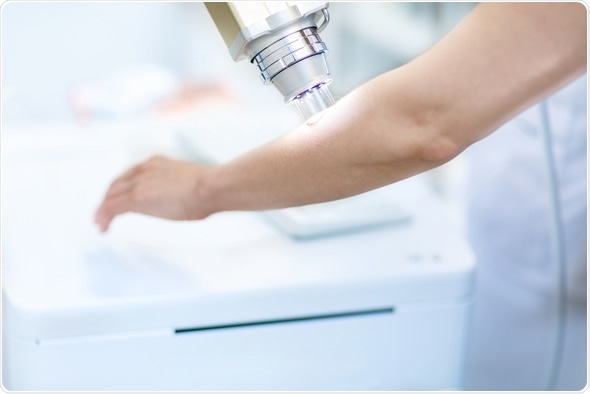There are various types of therapies that may be used in the management of dermatologic conditions. These can be broadly categorized as topical agents, dressings, systemic agents, laser and photodynamic therapy, and cryosurgery.

Professional skin examination in dermatology clinic. Image Copyright: SewerynCieslik / Shutterstock
Topical Agents
Topical agents are the most commonly used type of therapy used by dermatologists. They may be delivered in various vehicles, such as powders, liquids, and liquid-oil combinations. The vehicle is chosen by the dermatologist according to each situation, based on factors such as effectiveness, adverse effects, hydration of skin, area of use and patient preference.
- Powders are commonly used for lesions in moist areas such as under the arms or the genitalia
- Liquid solutions are commonly used for many areas due to their convenience, although they may dry the skin somewhat
- Liquid gels are commonly used when a controlled release preparation is needed
- Liquid lotions and foams are commonly used for hairy areas of the body because they are well absorbed
- Liquid baths are commonly used when large areas of skin are affected
- Liquid-oil combination creams are used for moisturizing and cooling the skin
- Liquid-oil combination ointments are usually more potent than creams and are commonly used for lesions with crusts or scales
Examples of topical agents that may be used in dermatologic therapy include:
- Cleansing agents (e.g. soaps, detergents, shampoos, solvents) to cleanse the skin
- Emollients (e.g. lotions, creams, ointments, bath oils) to restore moisture to the skin
- Antimicrobial agents (e.g. antibiotic, antifungal, insecticide, antiseptic agents) to prevent or eradicate infections of infestations.
- Anti-inflammatory agents (e.g. corticosteroids and non-steroidal lotion, gels, creams and lotions) to reduce inflammation
- Antipruritic agents (e.g. antihistamines and local anesthetics) to reduce itching of the skin
- Astringents (e.g. powders) to remove excessive moisture from intertriginous areas
- Keratolytic agents (e.g. salicylic acid and urea) to soften epidermal cells for exfoliation
Dressings
Dressings are often needed as part of dermatologic therapy to protect areas of the skin, enhance healing, improve absorption of topical agents and protect the clothing of the patient.
There are two types of dressings: non-occlusive and occlusive. Non-occlusive dressings such as gauze, allow the air to reach the wound and to dry the lesion, which can help with healing. Occlusive dressings allow less airflow and help to increase the absorption and effectiveness of topical agents applied to the area.
Systemic Therapies
Systemic therapies that affect the entire body are sometimes indicated for dermatologic conditions. Prime examples of this include the use of oral antibiotics, immunomodulator drugs, and injectable medications, that are effective in the management of dermatologic conditions.
Laser or Photodynamic Therapy
Laser therapy may be indicated to manage birthmarks and skin disorders such as vitiligo. It can also be used to remove tattoos or reduce hair growth, and to aid in cosmetic resurfacing and rejuvenation.
Photodynamic therapy can be used for skin cancer and precancerous growths. Additionally, phototherapy, with UVB (narrow band and broad band) and psoralen can be used in dermatologic therapy.
Cryosurgery
Cryosurgery is a technique that utilizes extremely cold temperatures to destroy unwanted tissues. This is a common type of dermatologic therapy that is often used in the treatment of warts, skin cancers and dermatosis.
Other Types of Therapies
There are also several other types of dermatologic therapies, including:
- Tumescent liposuction: a local infusion of dilute anesthetic causing the area to become firmer
- Cosmetic filler injections: injections used to improve cosmetic appearance
- Intralesional treatment: with steroids or chemotherapy
- Radiation therapy: rarely used but may be indicated in some instances
- Vitiligo surgery: such as autologous melanocyte transplant, suction blister grafting or punch grafting
- Allergy Testing: patch testing for contact dermatitis
References
Further Reading